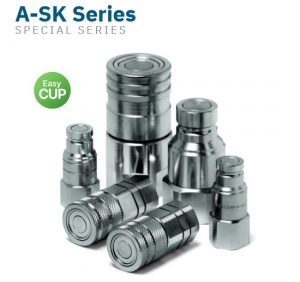Table of Contents
Aerospace Hydraulic GSE: Maintenance and Troubleshooting Part II – Troubleshooting Checklist
In the case of maintaining aerospace GSE, a good defense is the best offense, and preventing contaminants from entering the hydraulic system in the first place is the goal of hydraulic GSE preventive maintenance.
In Aerospace Hydraulic GSE: Maintenance and Troubleshooting Part I, we covered the types of hydraulic GSE equipment and the various sources of contamination that can occur. In Part II, we’ll cover what you can do to prevent contamination in hydraulic ground service equipment, in addition to using top-quality hydraulic quick couplers.
Preventing Contamination in Hydraulic GSE Equipment
Proper maintenance practices are essential to prevent contamination in hydraulic GSE equipment, ensuring reliable performance and protecting sensitive aircraft systems during service operations.
Use Coupler Protectant Caps
Be sure to use quick coupler protectant caps or plugs, and ensure they are in good operating condition. Only remove them for servicing. Ensure that the air filter is not saturated, as this can allow contaminants to enter the reservoir.
Monitor Fluid
Monitoring fluid regularly is essential to ensure your fluid meets the required specifications as well as the component manufacturer’s recommendations. Regular monitoring enables you to make adjustments to preventive maintenance programs as needed to maintain contamination levels within an acceptable range, thereby avoiding excessive expenses.
Fluid Compatibility
Various types of fluids are used in aircraft today, making it necessary to take extra precautions to keep all fluid types isolated. Engine oils, anti-icing fluids, phosphate ester, and petroleum-based hydraulic fluids all require different wetted materials in hydraulic aerospace GSE equipment. Fluid type identification placards should be visible on all unit,s and the same GSE equipment should never be used for more than one type of fluid.
If contamination with a foreign fluid occurs, all affected components must be thoroughly cleaned and dried prior to reusing or the contaminated components should be replaced.
Hydraulic GSE Maintenance and Troubleshooting Checklist
Part of a thorough GSE preventive maintenance plan includes knowing the condition of all fluids and components and maintaining an acceptable contamination level on operating components within OEM recommendations. The following maintenance and troubleshooting checklist will help to keep your aerospace hydraulic GSE equipment in top working condition:
- Inspect all quick disconnect couplings and protectant plugs for damage or leaks, repair or replace as necessary.
- Check the fluid filler cap for proper operation; replace it if necessary.
- Inspect all internal and external hoses for blistering, cuts, or worn areas that could leak fluid, and replace any damaged hoses.
- Inspect all indicator lights for proper operation.
- Inspect the cooling fan for proper operation.
- Replace the desiccant element/air filter regularly. A silica gel desiccant element will turn pink when it is saturated.
- Check the system pressure relief valve based on OEM recommendations.
- Check the condition of fluids periodically with laboratory analysis or using a portable monitor. Dehumidify and filter to achieve the specified levels as recommended by the OEM. Replace fluid as needed.
- Replace fluid filters on a regular schedule based on predetermined criteria, such as operating hours or with fluid samples.
- Verify the performance of hydraulic pumps based on OEM recommendations.
- Inspect the interior of the reservoir for visible buildup of silt or foreign materials. Drain and clean the unit before refilling it with new fluid.
- Check fluid levels of the reservoir, operating temperature, and fill as necessary.
- Operate the system and purge any air that may be entrapped.
- Circulate at various pressures and flows.
Following this checklist will help prolong the optimum operating life of aerospace GSE equipment and help identify potential issues and problems. Following a meticulous preventive maintenance schedule will help prevent contamination and costly equipment damage. In addition to preventive maintenance and timely repairs, utilizing hydraulic quick disconnect couplings designed explicitly for high-pressure aerospace applications can help prevent contamination and equipment damage.
Stucchi’s Hydraulic Solutions for Aerospace GSE Equipment
 Stucchi offers a wide selection of hydraulic quick disconnect couplings that meet the demands of aerospace GSE equipment. We cater your hydraulic solutions to meet your specific requirements and OEM recommendations. Our threaded flat face quick couplers are proven in high-pressure, demanding applications. The thread to connect design prevents premature wear and brinelling and prevents accidental disconnection. Our flat-face design eliminates leaks upon quick disconnect, preventing contamination of the hydraulic system and the environment.
Stucchi offers a wide selection of hydraulic quick disconnect couplings that meet the demands of aerospace GSE equipment. We cater your hydraulic solutions to meet your specific requirements and OEM recommendations. Our threaded flat face quick couplers are proven in high-pressure, demanding applications. The thread to connect design prevents premature wear and brinelling and prevents accidental disconnection. Our flat-face design eliminates leaks upon quick disconnect, preventing contamination of the hydraulic system and the environment.
Our stainless steel hydraulic fittings withstand extreme temperatures and pressures while maintaining optimal fluid flow. Multi-coupling plates enable quick and easy connection and disconnection of multiple lines with a single movement. Stucchi offers various multi-plate solutions with either the same or different sizes of couplings and the same or various types of media, such as hydraulic fluid, electric, or pneumatic lines. Eliminate the risk of cross-contamination and ensure a reliable, locking connection that prevents unwanted disconnection and contamination.
Stucchi’s hydraulic specialists customize your hydraulic quick-connect and disconnect solution to meet your specific needs and maximize your operating efficiency. We adhere to a strict quality policy as part of our ISO 9001:2015 certification, ensuring total customer satisfaction through high-quality products and services. Contact us with any questions and to learn more about maintaining and troubleshooting aerospace hydraulic GSE equipment.


